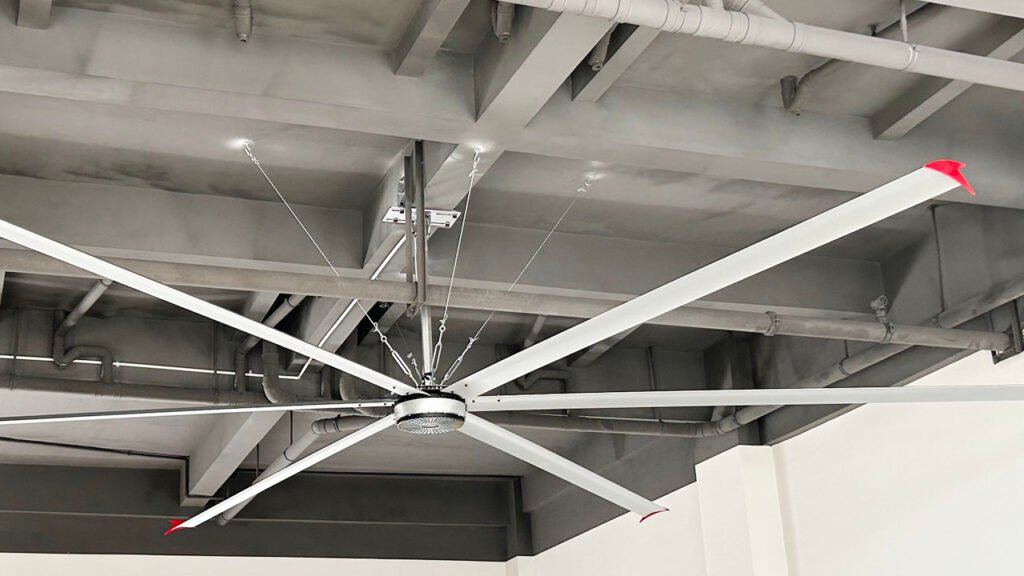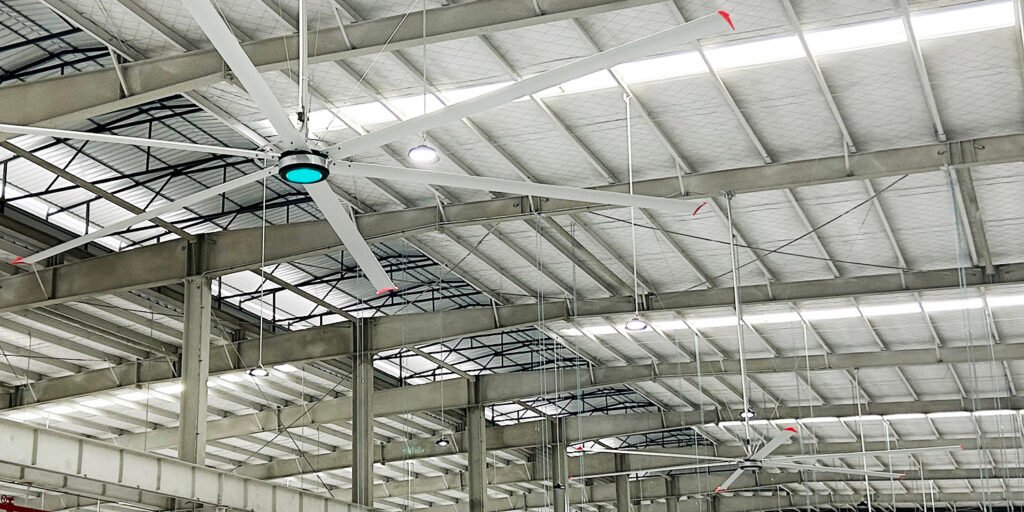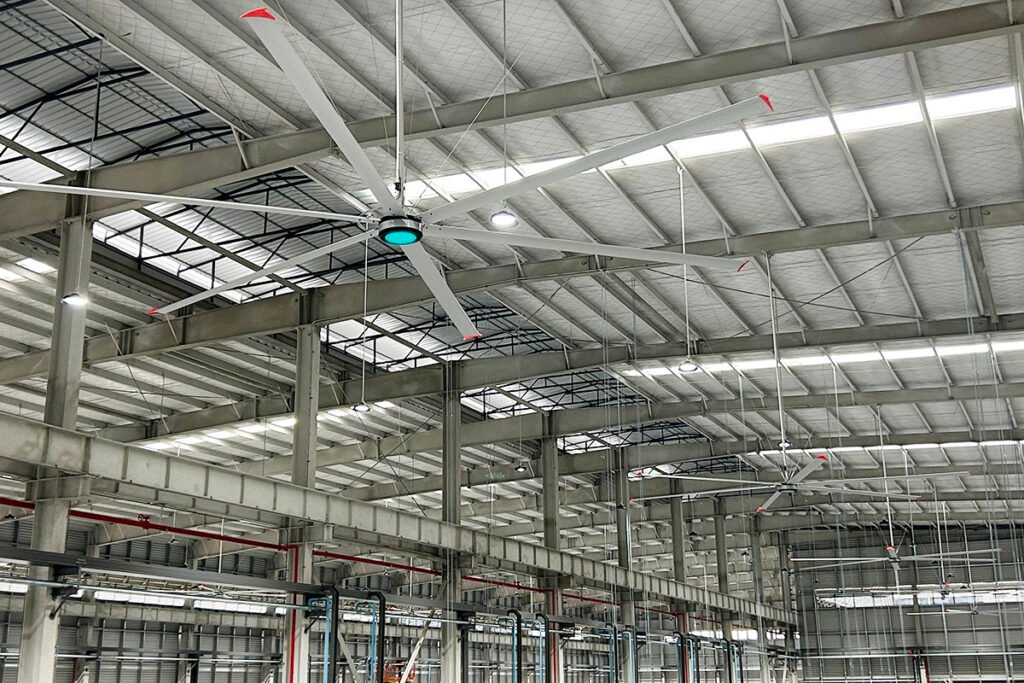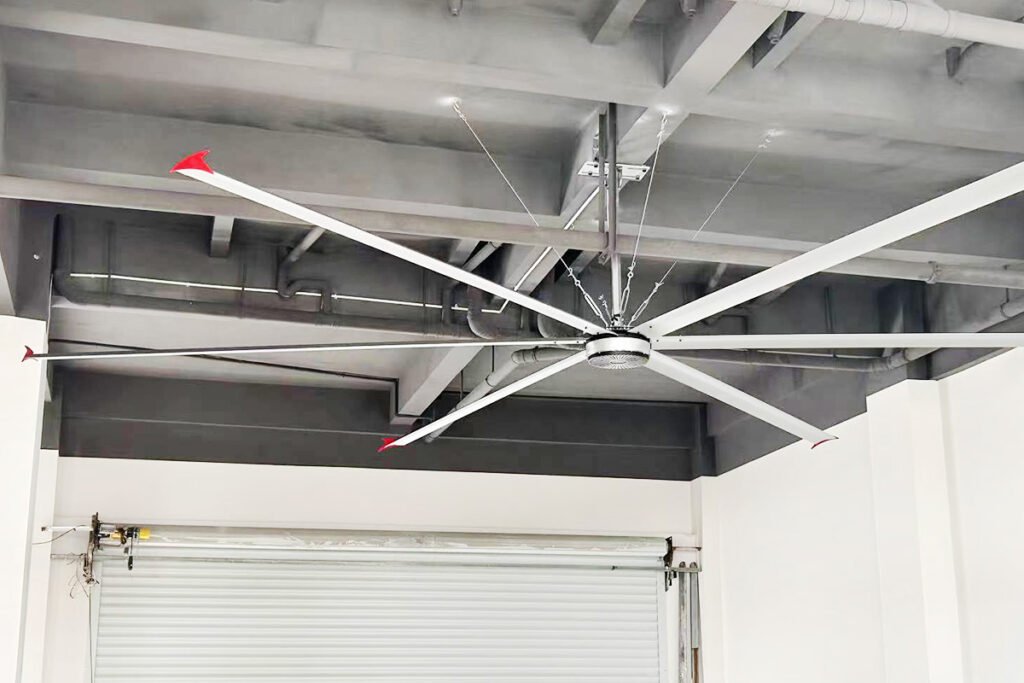
The design parameters and calculation methods for HVLS fans involve several aspects, including the size, speed, airflow, pressure, power, and noise of the fan. Here are some key design parameters and calculation methods:
- Fan Diameter (D): The diameter of HVLS fans typically ranges from 3.6 meters to 7.3 meters. The diameter directly affects the airflow and pressure.
- Rotational Speed (N): The rotational speed of HVLS fans is usually below 100 revolutions per minute (RPM). The speed affects the airflow and pressure.
- Airflow (Q): Airflow is the amount of air a fan can move in a unit of time, usually measured in CFM (cubic feet per minute) or m³/h (cubic meters per hour). Airflow is directly proportional to rotational speed and proportional to the cube of the diameter.
- Pressure (P): Pressure refers to the resistance a fan can overcome, usually proportional to the square of the rotational speed and proportional to the square of the diameter.
- Power (W): Power is the energy required for the fan to operate, proportional to the cube of the rotational speed.
- Noise: The noise level of HVLS fans is typically very low, generally around 45 dBA.
- Air Density (ρ): Air density affects airflow and pressure, but it can be considered a constant in most applications.
Fan laws are a set of principles describing the relationships between fan performance parameters, including the law of airflow, the law of pressure, and the law of power. These laws can help calculate the performance of fans under different conditions.
- Airflow Law: Airflow is directly proportional to rotational speed. If the speed doubles, the airflow also doubles.
- Pressure Law: Pressure is proportional to the square of the rotational speed. If the speed doubles, the pressure increases by four times.
- Power Law: Power is proportional to the cube of the rotational speed. If the speed doubles, the power increases by eight times.
Actual calculations also need to consider the efficiency of the fan and other system resistances. The selection and design of fans usually need to be based on specific application scenarios and requirements, including the size of the space, air circulation needs, energy consumption requirements, etc.
When designing HVLS fans, other factors such as the installation location of the fan, the structure of the building, and the control system of the fan also need to be considered. For example, the installation height and position of the fan affect its coverage area and air movement effect. In addition, modern HVLS fans may be equipped with advanced control systems, such as vector frequency control, to achieve more precise speed control and energy-saving effects.
Overall, the design and calculation of HVLS fans is a comprehensive process that requires detailed planning and calculation based on specific application needs and site conditions.





HVLS fans, which stand for High Volume, Low Speed fans, are designed specifically for large spaces. They use large blades rotating at low speeds to move large amounts of air, creating a comfortable breeze effect. This effectively promotes air circulation, improves human comfort, and helps to save energy.
The main design parameters of HVLS fans include:
- Fan Diameter: Common diameters include 7.3 meters, 6.1 meters, 5.5 meters, 4.9 meters, and 3.6 meters. Different diameters affect the coverage area and airflow of the fan.
- Adjustable Speed: The speed of HVLS fans usually ranges from 0-60rpm to 0-110rpm, depending on the fan’s diameter and design.
- Full Load Air Volume: The airflow varies among different models; for example, a fan with a 7.3-meter diameter can reach up to 14130m³/min, while a fan with a 3.6-meter diameter is 6560m³/min.
- Coverage Radius and Range: The coverage radius and range of the fan also vary with the model, with larger diameter fans covering a wider area.
- Motor Noise: The noise level of HVLS fans is usually very low, typically around 45dba, making them suitable for environments that require quietness.
- Overall Weight: The weight of the fan varies depending on the model, ranging from 42kg to 95kg.
- Motor Power: The motor power usually ranges from 0.4kw to 1.5kw, with motor types including asynchronous motors and permanent magnet synchronous motors.
- Current Voltage: The current voltage requirements for fans also differ, such as 2.2A/380V, 2.4A/220V, etc.
- Blade Design: The blades are typically designed with streamlined shapes to optimize aerodynamic performance.
- Materials: The materials for fans need to be researched and applied for magnesium aluminum alloys, metal structural parts, etc., to achieve lightweight, safety, and durability.
- Control System: HVLS fans may be equipped with advanced control systems, such as vector frequency control, to achieve smooth start-stop and safe control.
- Safety Features: Include multiple safety protection measures, such as safety ropes, safety rings, anti-drop axis sleeve technology, etc.
These design parameters determine the performance and applicability of HVLS fans, enabling them to meet the ventilation needs of different large spaces. When selecting HVLS fans, the appropriate model and configuration should be determined based on the actual size and height of the space, as well as the required airflow and coverage area.
